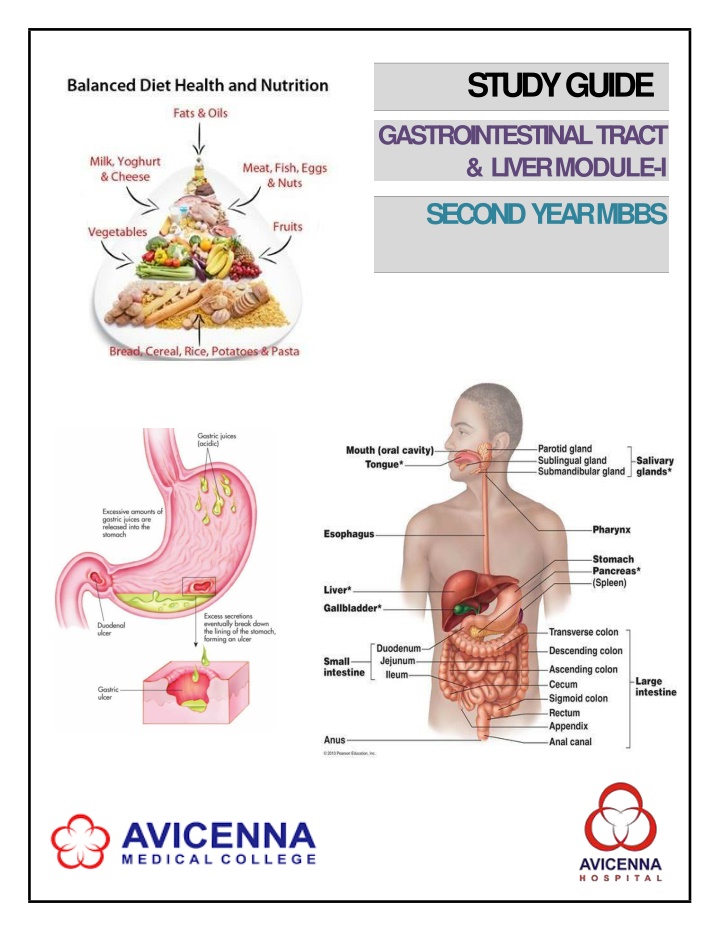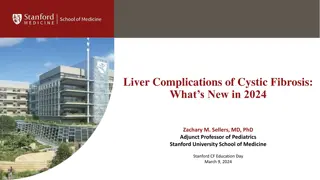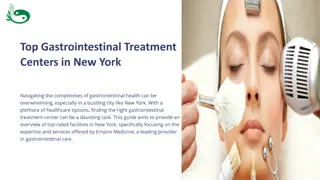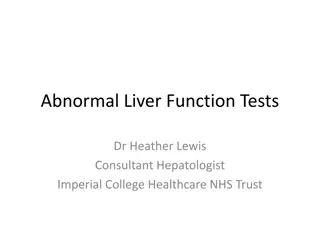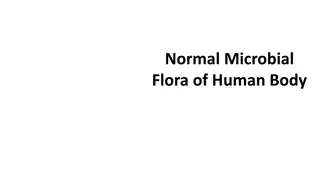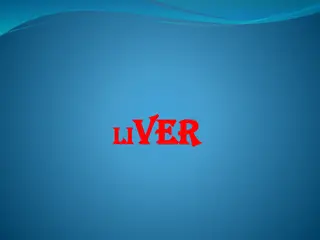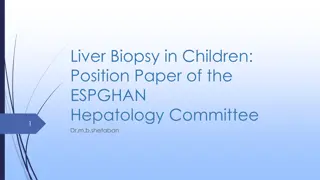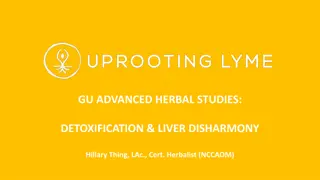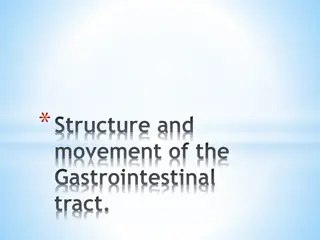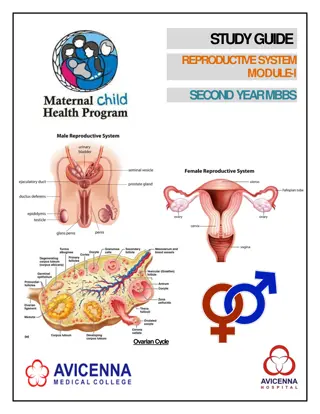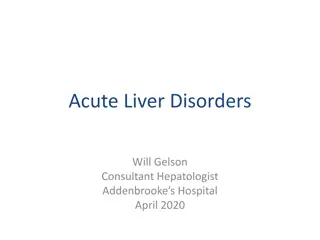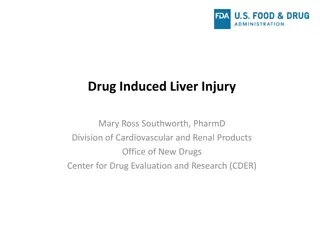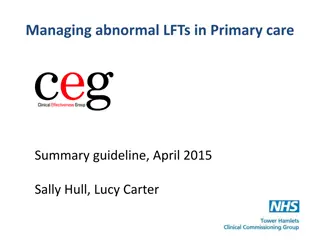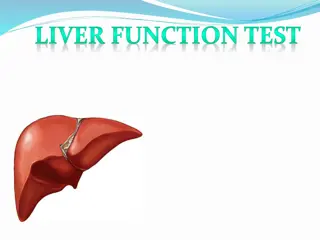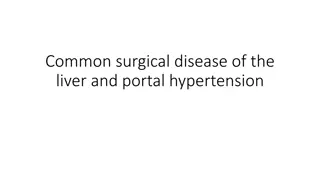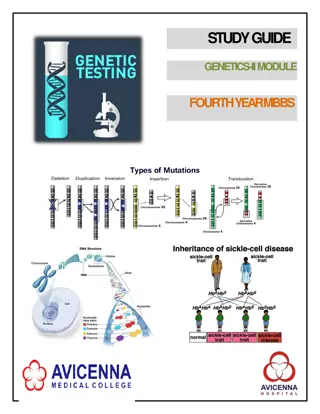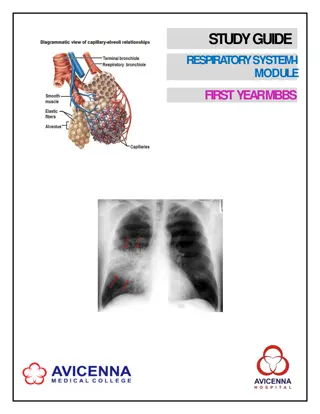Study Guide: Gastrointestinal Tract & Liver Module for Second Year MBBS Students
Comprehensive study guide for second-year MBBS students at Avicenna Medical College covering the Gastrointestinal Tract & Liver Module. The guide includes information on learning methodologies, assessment methods, modular examinations, curriculum framework, and integrated teaching approaches. It provides detailed insights into objectives, learning strategies, resources, and regulations to help students succeed in their studies.
Download Presentation

Please find below an Image/Link to download the presentation.
The content on the website is provided AS IS for your information and personal use only. It may not be sold, licensed, or shared on other websites without obtaining consent from the author.If you encounter any issues during the download, it is possible that the publisher has removed the file from their server.
You are allowed to download the files provided on this website for personal or commercial use, subject to the condition that they are used lawfully. All files are the property of their respective owners.
The content on the website is provided AS IS for your information and personal use only. It may not be sold, licensed, or shared on other websites without obtaining consent from the author.
E N D
Presentation Transcript
STUDYGUIDE GASTROINTESTINALTRACT & LIVERMODULE-I SECOND YEARMBBS
2ND YEAR MBBS, GIT & LIVER IMODULE STUDY GUIDE FOR GASTROINTESTINAL TRACT & LIVERMODULE-I Page No 3 4 5 7 7 8 21 23 25 26 S.No CONTENTS 1 2 3 4 Overview Introduction to StudyGuide LearningMethodologies Module 1: GIT & Liver-I Importance of GIT &Liver Objectives and Learningstrategies LearningResources AssessmentMethods Modular Examination Rules and Regulations(AVMC) Schedule 4.1 4.2 5 6 7 8 Page | 2
2ND YEAR MBBS, GIT & LIVER IMODULE AVICENNA MEDICAL COLLEGE Year:One Duration: 4 weeks Timetable hours: Lectures, Case-Based Learning (CBL), Team based Learning (TBL), Self-Study, Practical, Skills, Demonstrations, Field Visits, Visit to Wards& Laboratory MODULE INTEGRA TEDCOMMITTEE MODULECOORDINATOR: CO-COORDINATORS: Professor Dr. Zubair Ahmad(Biochemistry) Professor Dr. Rubina Hafeez (Pathology) Professor Dr.Rehana Shahid(Anatomy) DEPARTMENTS & RESOURCE PERSONS FACILITA TINGLEARNING BASIC HEALTHSCIENCES CLINICAL AND ANCILLARYDEPARTMENTS FAMILYMEDICINE Professor Dr. Muhammad Luqman ANATOMY Professor Dr.Rehana Shahid BIOCHEMISTRY Professor Dr. Zubair Ahmad MEDICALEDUCATION Professor Dr. Waheed Ahmad COMMUNITYMEDICINE Professor Dr. Rana Muhammad Akhtar Khan INTERNALMEDICINE Dr. Muhammad Usman Amir PATHOLOGY Endocrinology Prof. Dr. Waheed Ahmed Professor Dr. Rubina Hafeez PHYSIOLOGY Professor Dr. Binyamin Ahmad PHARMACOLOGY Professor Dr. Rana Tariq Mehmood AVMCMANAGEMENT Professor Dr. Gulfreen Waheed, PrincipalAVMC Brig.Dr. Gul e Rana , Director AVMC Dr. Sadia Awan Dr. Muhammad Muzzammil Sadiq Dr. Usama Bin Ishtiaq STUDY GUIDE COMPILEDBY: Department of Health CareEducation Page | 3
2ND YEAR MBBS, GIT & LIVER IMODULE INTRODUCTION WHAT IS A STUDYGUIDE? It is an aidto: Inform students how student learning program of the semester-wise module has been organized Helpstudentsorganize andmanagetheirstudiesthroughoutthemodule Guide students on assessment methods, rules andregulations THE STUDYGUIDE: Communicates information on organization and management of themodule. Thiswill helpthestudentto contactthe rightpersonin caseof anydifficulty. Definestheobjectiveswhich areexpectedto beachieved at theendof themodule. Identifies the learning strategies suchasInteractive Lectures,smallgroupteachings, clinical skills, demonstration, tutorial and casebasedlearning that will be implemented to achieve the module objectives. Provides a list of learning resources such as books, computer assisted learning programs, web- links,journals,forstudentsto consultin orderto maximize their learning. Highlights information on the contribution of continuous and semester examinations on the student s overallperformance. Includes information on the assessment methods that will be held to determine every student s achievement ofobjectives. Focuses on information pertaining toexamination policy, rules and regulations. CURRICULUMFRAMEWORK Students will experience integrated curriculum in 4th semesters at LNMC in accordance with theJSMU guidelines and most recent developments that have an impact on individual health. INTEGRATED CURRICULUM comprises of system-based modules such as GIT & Liver-I, Renal & Excretory System-I and Reproduction-I which links basic science knowledge to clinical problems. Integrated teaching means that subjects are presented as a meaningful whole. Students will be able to have betterunderstandingof basicscienceswhentheyrepeatedlylearn in relation to clinical examples. Case-based discussions, computer-based assignments, early exposure to clinics, wards, and skills acquisition in skills lab and physiotherapy department are characteristics of integrated teachingprogram. Page | 4
2ND YEAR MBBS, GIT & LIVER IMODULE LEARNINGMETHODOLOGIES Thefollowing teaching/ learningmethodsareusedto promotebetterunderstanding: InteractiveLectures Hospital / Clinic visits Small Group Discussion Case-BasedLearning Practicals Skillssession Self-study INTERACTIVELECTURES In large group, the Interactive Lecturer introduces atopic or common clinical conditions and explains the underlying phenomena through questions, pictures, videos of patients interviews, exercises, etc. Studentsareactivelyinvolved in the learning process. HOSPITAL VISITS: In small groups, students observe patients with signs and symptoms in hospital or clinical settings. This helps students to relate knowledge of basic and clinical sciences of the relevant module. Page | 5
2ND YEAR MBBS, GIT & LIVER IMODULE SMALLGROUPDISCUSSION(SGD):Thisformat helps students to clarify concepts acquire skills or attitudes. Sessions are structured with the help of specific exercises such as patient case, interviews or discussion topics. Students exchangeopinions and apply knowledgegained from Interactive Lectures, tutorials and self study.Thefacilitator role isto askprobing questions,summarize,or rephraseto help clarify concepts. CASE- BASED LEARNING: A small group discussion format where learning is focused around a series of questions based on a clinical scenario. Students discuss and answer the questions applying relevant knowledge gainedin clinical andbasichealth sciencesduring themodule. PRACTICAL: Basic science practicals related to anatomy, biochemistry, pathology, pharmacology and physiologyarescheduledfor studentlearning. SKILLSSESSION:Skills relevant to respective module are observed and practiced where applicable in skills laboratory or DepartmentofPhysiotherapy. SELFSTUDY: Students assume responsibilities of their own learning through individual study, sharing and discussing with peers, seeking information from Learning Resource Center, teachers and resource persons within andoutside the college.Studentscanutilize the time within the college scheduled hours ofself-study. Page | 6
2ND YEAR MBBS, GIT & LIVER IMODULE SEMESTER 4 MODULE 1: GIT &LIVER INTRODUCTION In this module, medical students will learn in detail the normal structure, function and diseases of GI Tract and hepatobiliary system. From Pakistan s context, the prevalence and significance of GIT and liver illnesses can be judged from the total days that adults and children who are affected remain absent from work or schools; numberof admissions to hospitals;andnumberof surgicalproceduresperformed. Children and adults present to general practice, or hospitals with signs and symptoms of some of very common illnesses related to GIT & Liver including vomiting, chronic diarrhea, constipation, peptic ulcers, enteric fever, malnutrition, jaundice etc. This module will provide students opportunities to understand the basis of these illnesses including the mechanism involved in the development of these pathologies and integrate basic medical science knowledge to clinicalproblem-solving. Students will identify how GI structure (Embryology, Microscopic Anatomy and Gross Anatomy) integrates with function (physiologic mechanisms of GI motility, digestion and absorption, and liver and pancreatic function). During the module, students will acquire a wider, more generally applicable knowledge of immunology, metabolism, infectious disease and pathology related to the GI system. Therefore, the overall objective of this course is to provide an integrative understanding of the structure and functions of the gastrointestinal tract. Page | 7
2ND YEAR MBBS, GIT & LIVER IMODULE COURSE OBJECTIVES ANDSTRA TEGIES At theendof themodulethestudentswill beableto: LEARNING STRATEGIES TOPICS &OBJECTIVES FACULTY 1. Introduction ofGIT a) Classify the nutrients b) Describe effects of nutrient deficiency onhealth c) Explain control measures and prevention ofnutrient deficiency d) Classify macro andmicronutrients e) Describe theroleof micronutrients in body metabolism f) List diseases caused by micronutrientdeficiency g) Explain control measures and preventionof micronutrientdeficiency h) Define balanceddiet i) Explain energy value and bioavailability ofnutrients j) Describe composition of macronutrient inbalanced diet k) Calculate energy value frommacronutrient l) Discuss the abdominal quadrants with their contents and surface landmarks of theabdomen m) Discuss the characteristics of gastrointestinalwall n) Explain functional types of movements inGIT o) Describe gastrointestinal blood flowbriefly 2. Control ofGIT a) Describe autonomic nervoussystem b) Explain Myenteric and Meissner splexus c) List GIT hormones and their role in digestiveprocess d) Describe GITreflexes 3. Radiological assessment of GIT Communit y Medicine Small GroupDiscussion Anatomy Tutorial Interactive Lecture/Smallgroup discussion Physiology Interactive Lecture/Smallgroup discussion Physiology a) Identify various parts of normal GIT on plain X-ray Radiology InteractiveLecture 4. Mastication and salivarysecretions a) Describe the masticationreflex b) Describe phases of deglutition c) Explain lower esophageal tone andmotility disorders d) List the salivaryglands e) Discuss regulation of secretion ofsaliva (stimuli and control) f) Discuss the salivary composition andfunctions Practical Physiology Interactive Lecture/Smallgroup leaning InteractiveLecture Page | 8
2ND YEAR MBBS, GIT & LIVER IMODULE 5. Development of foregut, midgut and hindgut & congenitalanomalies a) Explain the process of development of GIT and divisions of primitivegut b) Describe the derivatives of foregut , midgut& hindgut c) Describe the development of: i. Esophagus ii. Stomach iii. Lesser & greatersac iv. Small and largeintestine d) Discuss the common congenital anomalies involvingforegut: i. esophagealatresia/stenosis ii. congenital hypertrophic pyloricstenosis iii. duodenal atresia/stenosis iv. accessoryspleen e) Discuss the common congenital anomalies involving midgut & hindgut i. congenitalomphalocele ii. Gastroschisis iii. umbilical hernia iv. intestinal atresia/stenosis v. malrotationofgut vi. ilealdiverticulum vii. intestinalduplication viii. Hirchsprung'sdisease ix. rectal atresia x. imperforate anus and analstenosis f) Describe thedevelopmentof liver, biliary apparatus & pancreas and their congenitalanomalies i. extrahepatic biliaryatresia ii. annularpancreas iii. accessory pancreatictissue g) Discuss the molecular regulation of Liver & Pancreas development Interactive Lecture/Smallgroup discussion Anatomy h) Describe the following congenital anomaliesof GIT: i. Atresia ii. Fistulae iii. Diaphragmatichernia iv. Omphalocele v. Gastroschisis vi. Ectopia vii. Meckeldiverticulum viii. Congenital hypertrophic pyloric stenosis ix. Hirschsprung disease Pathology InteractiveLecture Page | 9
2ND YEAR MBBS, SEMESTER 4 GIT & LIVER IMODULE 6. Peritonealcavity a) Explain the layers, folds, recessesand compartmentsof peritoneumwith theirclinical importance b) Discusstheextent of peritoneum,peritonealcavity andreflections c) Explain the boundaries of greater &lesser sac Anatomy InteractiveLecture 7. Smoothmuscles a) Discuss the functions of smoothmuscles and their electric properties b) Explain smooth muscle contractionmechanism c) Differentiate between smooth and skeletalmuscles d) Describe genesis of BER and its role in GImotility 8. Esophagus andStomach a) Demonstrate the microscopic features ofesophagus andstomach b) Explain the gross anatomy of abdominalesophagus with its peritoneal & visceral relations, neurovascular supply , lymphatic drainage and clinical importance c) Explain the gross anatomy of stomach withits peritoneal & visceral relations, neurovascular supply, lymphatic drainage and clinicalimportance d) Describe motor functions ofstomach e) Explain regulation of stomachemptying f) Describe the composition, function andregulation of gastricsecretions Interactive Lecture/Smallgroup discussion Physiology Interactive Lecture/Smallgroup discussion Anatomy Small groupdiscussion Interactive Lecture/Smallgroup discussion Physiology g) Discuss the causes and mechanismtriggering vomiting h) Discuss classification, mechanism of action, pharmacokinetics and adverse effects ofantiemetic and prokineticdrugs Pharmacology InteractiveLecture i) j) Classify esophagitis based on etiology Explain esophageal obstruction, varices and achalasia k) Explain the Barret esophagitis (riskfactors, pathogenesis,morphology) l) Describe acute and chronic gastritis withemphasis on H. Pylori gastritis and autoimmunegastritis m) Define peptic ulcer n) Discuss its pathogenesis and relation to H.Pylori infection o) Perform abdominalexamination InteractiveLecture Small groupdiscussion Pathology InteractiveLecture InteractiveLecture Skills Lab Small groupdiscussion Page | 10
2ND YEAR MBBS, GIT & LIVER IMODULE 9. Pancreas a) Explain the gross anatomical features ofpancreas with its neurovascular supply, peritonealrelations and clinical importance b) Demonstrate the microscopic features ofpancreas Small groupdiscussion Anatomy Practical Interactive Lecture/Smallgroup discussion c) Discuss the composition, function and regulationof pancreaticsecretion Physiology d) Describe the non tumorous condition ofpancreas (congenital anomalies, acute pancreatitis,non- neoplasticcysts) e) Discuss the risk factors foracid peptic disease f) Classify drugs used for treatment of acidpeptic disease g) Discuss the mechanism of action,pharmacokinetics, therapeutic uses, adverse effects and drug interaction of H2 receptorantagonist h) Discuss the mechanism of action,pharmacokinetics, therapeutic uses, adverse effects and drug interaction of protonpump inhibitor i) Discuss the mechanism of action,pharmacokinetics, therapeutic uses, adverse effects and drug interaction of mucosal protective agents suchas Sucralfate, colloidal Bismuth compounds and prostaglandins Pathology InteractiveLecture InteractiveLecture InteractiveLecture Pharmacology InteractiveLecture j) Explain the mechanism of action,pharmacokinetics, therapeutic uses and adverse effects ofAntacids k) Discuss the antimicrobial drugs used in the treatment of H. Pyloriinfection 10. Small and largeintestine a) Demonstrate the microscopic features of smalland largeintestine InteractiveLecture InteractiveLecture Practical b) Differentiate between the parts ofsmall and large intestine on the basis ofanatomical features with neurovascular supply and lymphaticdrainage c) Listthe clinical conditions relatedto small& large intestine like volvulus andintussusception d) List different enzymes secretions ofsmall and large intestines e) Describe regulation of differentenzymes secretions of small and largeintestines f) Describe segmentation, peristalsis, massmovement and defecationreflex g) Describe effects of autonomic system inmodulating intestinalmotility h) Explain vomiting reflex and itscauses Anatomy Small groupdiscussion InteractiveLecture Physiology Interactive Lecture/Smallgroup discussion Small groupdiscussion Page | 11
2ND YEAR MBBS, GIT & LIVER IMODULE i) Discuss malabsorption diseases (cystic fibrosis, celiac disease, environmental enteropathy, autoimmune enteropathy, lactasedeficiency) Discuss pathogenesis, risk factors, morphology and clinical features of celiacdisesase k) List causes of malabsorption anddiarrhea l) Discuss the inflammatory boweldiseases m) Differentiate between ulcerative colitis andCrohn s disease with risk factors, pathogenesis,morphology, clinical features anddiagnosis n) Explain irritable boweldisease Small groupdiscussion j) Pathology InteractiveLecture Interactive Lecture/Smallgroup discussion o) Classify anti-diarrhreal drugs with their pharmacokinetics and clinical uses Pharmacology p) List signs and symptoms of entericfever q) Discuss investigation and diagnosis of entericfever r) Discussroleof immunization in preventionof enteric fever s) Describe the epidemiology and prevention of enteric/typhoidfever t) Discuss the clinical importance of appendix andits neurovascularsupply 11. Rectum & analcanal Communit y Medicine InteractiveLecture Anatomy InteractiveLecture a) Demonstrate the microscopic features of rectum and analcanal b) Discuss the structure, neurovascular supply and clinical importance ofrectum c) Discuss the structure, neurovascular supplyand clinical importance of anorectal junctionand anal canal d) Discuss the defecation reflex and itsregulation Practical Small groupdiscussion Anatomy Small groupdiscussion Interactive Lecture/Smallgroup discussion Physiology e) Differentiate between laxatives and purgatives based on their classification, mechanism ofaction, pharmacokinetics, therapeutic uses and adverse effects 12. Liver & Hepatic portalsystem a) Demonstrate the microscopic features ofliver parenchyma with general concepts of hepatic lobule, portal lobule and hepaticacinus b) Describe the microscopic structure ofgall bladder c) Explain the histological features of exocrine partof pancreas d) Describe the gross features, neurovascularsupply andclinical correlation of liver, gallbladderand extra-hepatic biliary apparatus Pharmacology InteractiveLecture Practical Anatomy Small groupdiscussion Page | 12
2ND YEAR MBBS, GIT & LIVER IMODULE e) Explain the venous drainage of organs of GIT, hepatic portal system, its tributariesand sites of porto-systemic anastomosis with itsclinical importance f) Discuss clinical features investigations ofhepatic diseases g) Recognize the patterns of hepaticinjury, cholestasis, jaundice and portal hypertension, cirrhosis and liverfailure InteractiveLecture Interactive Lecture/Smallgroup discussion Pathology h) List the causes of circulatory diseases ofliver i) j) List the hepatic diseases associated with pregnancy Enumerate viral and other infectious causesof hepatitis k) Discuss acute and chronic hepatitis, their causes, clinical features and labvalues l) ClassifyHepatitis m) Describe signs and symptoms of Hepatitis A, B, C andE n) Describe host, agent and environment ofHepatitis A,B,C andE o) Explain control measures and preventionof Hepatitis A,B,C andE p) Discuss Hepatitis control program ofPakistan q) Discuss the clinical anatomy ofspleen Microbiology ? Communit y Medicine InteractiveLecture Anatomy Small groupdiscussion 13. Gall bladder and biliarytract a) Describe the gross features, neurovascularsupply and clinical importance of gall bladderand extra- hepatic biliary apparatus Small groupdiscussion Anatomy b) Discuss the microscopic features of gallbladder Practical c) Describe composition of bile and itsregulation d) Explain conjugation and secretion of bilesalts e) Explain role of bile acids in fatsemulsification f) Describe enterohepatic circulation of bilesalts Physiology InteractiveLecture 14. Anterior and posterior abdominal wall a) Describe the fascia, muscles and neurovascular supply of anterior and posterior abdominalwall b) Explain formation of rectus sheath with itscontents c) Discuss the features of lumbarvertebrae Anatomy Small groupdiscussion d) Discuss the anatomical features and clinical importance of inguinalcanal e) Differentiate between different types of abdominal and inguinalhernia Page | 13
2ND YEAR MBBS, GIT & LIVER IMODULE 15. Blood supply, nerve supply, lymphatics and surface anatomy of abdomen a) Describe the paired and unpaired branches of abdominal aorta and theirsupply b) Discuss the formation, extent, course and tributaries of Inferiorvena cava c) List the branches of lumbosacral plexussupplying abdominalwall d) Discuss lymphatic drainage and nerves of abdomen, formationof cisternachyliand thoracicduct Small groupdiscussion Small groupdiscussion Anatomy InteractiveLecture 16. Digestion & Absorption ofCarbohydrates a) Describe dietary carbohydrates and theiraction b) Explain the significance of the glycemicindex c) Describe the importance of dietaryfibers d) List the main digestive enzymes and describe their action oncarbohydrate e) Discuss the abnormalities due to digestive enzyme deficiency f) Explain the absorption of monosaccharaides bythe intestinal mucosalcells g) Explain the significance of lactoseintolerance h) Perform serum glucose estimation (kit method) 17.Digestion & Absorption ofProteins a) List the various sources of dietary protein b) Discuss the digestion of protein in the stomach and intestine InteractiveLecture Biochemistry Practical c)List and explain the function of the proteolytic enzymes Biochemistry d) Explain the mechanism of absorption of aminoacids e) Discuss the biomedical importance of protein allergy, celiac sprue andcystinuria f) Discuss the significance of amino acidpool InteractiveLecture g) Explain the significance of nitrogenbalance. 18.Digestion & Absorption ofLipid a) List the constituents of dietary lipids b) List causes of steatorrhea c) Discuss the digestion of lipid in the stomach and smallintestine d) Explain the role of lipases in lipiddigestion InteractiveLecture Biochemistry Page | 14
2ND YEAR MBBS, GIT & LIVER IMODULE e) Discuss the digestion of dietary cholesteroland phospholipid f) Explain the hormonal regulation oflipid digestion g) Discusstheabsorption oflipid bytheintestinal mucosalcells h) Discuss the resynthesize and secretion of lipidby theenterocytes i) Discuss the secretion ofchylomicron by the enterocytes j) Discuss the abnormalities of lipid digestion and absorption with especial reference tocystic fibrosis Biochemistry InteractiveLecture k) Explainsteatorrhoea 19. Glycolytic Pathway of Carbohydrates Metabolism a) Differentiate between aerobic andanaerobic glycolysis b) Explaintherole of insulin in transportof glucose inside thecells c) Listthe reactionsof thetwo stagesof glycolysis o Energy investment and o Energygeneration d) Explain the hormonal regulation ofglycolysis InteractiveLecture Biochemistry e) Discuss the fate ofpyruvate f) Explain the process of glycolysis inRBC s 20. TCA Cycle of CarbohydratesMetabolism a) Discuss the significance of TCA cycle as an amphibolic pathways b) Discuss the reactions of the TCA cycle and its regulatory steps c) Describe the energy produced from TCAcycle InteractiveLecture Biochemistry d) Explain the disorder of TCA cycle with special re ference to PDHdeficiency InteractiveLecture 21.Metabolism of Glycogen with ItsDisorders a) Explain the structure and function ofglycogen b) Describe the mechanism of glycogen synthesisand itsregulation c) Describe the mechanism ofglycognenolysis and its regulation Biochemistry InteractiveLecture d) Discuss the maintenance of blood glucoselevel Page | 15
2ND YEAR MBBS, GIT & LIVER IMODULE e) Explain the various form of glycogen storage diseases 22. Metabolic Pathway ofGluconeogenesis a) Describe the mechanism ofgluconeogenesis b) List the reactions which are uniqueto gluconeogenesis c) Explain the mechanism of transport ofoxaloacetic acid to thecytosol d) Describe how gluconeogenesis is along with their regulatory enzymes Biochemistry InteractiveLecture e) Explain the Coricycle 23. Metabolic Pathway of HMP Shunt a) Describe the significance ofhexose monophosphateshunt b) Describe the oxidative and non-oxidative stages of HMPshunt c) Discuss the enzymes of the HMP shunt andits regulation. d) Explain the abnormalities of the HMPshunt especiallyG6PD. e) Discuss the significance of reactiveoxygen species Biochemistry InteractiveLecture f) Discuss the functions of NADPH andglutathione 24. Metabolic Pathway of Fructose & Galactose a) List the sources offructose b) Discuss the alternative mechanismof monosaccharide metabolism c) Discuss the important enzymes offructose metabolism d) Explain the metabolic pathway offructose e) Explain the disorders occur in fructose metabolism due to enzymedeficiencies f) Discusstheimportantenzymesofin Galactose metabolism g) Explain the metabolic pathway of Galactose metabolism h) Explain the disorders occur in Galactose metabolism due to enzymedeficiencies i) Describe the importance ofuronic acid pathway in liver detoxification Biochemistry InteractiveLecture Page | 16
2ND YEAR MBBS, GIT & LIVER IMODULE 25. Bioenergetics & BiologicalOxidation a) List high energy and low energyphosphate b) List the oxido-reductase enzyme c) Define bioenergetics and explain the general lawsof thermodynamics d) Define free energy and equilibrium constant Biochemistry InteractiveLecture e) Describe the coupling of endergonic and exergonic reactions by high energy intermediate (e.g.ATP) f) Describe the role of ATP as a energycarrier g) Describe biologic oxidation and redoxpotential 26. Oxidative Phosphorylation & Electron TransportChain a) List the ion transporters in the inner mitochondrial membranes b) List the genetic defects of oxidativephosphorylation c) Explain the energy currency of thebody d) Explain the site and mechanism of synthesis ofATP e) Describe the organization of the electron transport chain f) Discussthe functionsof eachcomplexof ETC g) Describe how proton are pumped from the matrix to the intermembranespace h) Discuss the significance of co-enzyme Q and theQ- cycle Biochemistry InteractiveLecture i) Discuss the inhibitors and uncouplers ofETC and their mechanism ofaction j) Discuss how electron transport chain releasesfree energy k) Discuss the generation of proton gradient l) Explain the significance of P.O.Ratio m) Explain Mitchell s chemiosmosis theoryof electrochemicalgradient n) Explain the glycerophosphate and malateshuttle 27. Metabolic Role of Liver & ItsDetoxification a) List the liver function tests based on the fivemain functions of theliver Biochemistry InteractiveLecture b) Discuss the metabolic, synthetic, excretory, detoxification and storage functions ofliver Page | 17
2ND YEAR MBBS, GIT & LIVER IMODULE c) Explain the normal level of serum bilirubin (total, conjugated and unconjugated), urinary urobilinogen, urinary bilirubin, fecalstercobilinogen in different types ofJaundice Biochemistry InteractiveLecture d) Discuss the importance of serum enzyme in the differential diagnosis of Jaundice (ALT, AST, ALP, LDH, GGT, and5 -Nucleotidase) e) Discuss the importance of albumin, total protein and prothrombin time in diagnosing liverdisease 28. Degradation of Hemoglobin and Bilirubin Metabolism a) List the steps of heme degradation tobilirubin b) Discusstherole of liver in bilirubinuptakeand conjugation c) Discuss the secretion ofbilirubin in bile d) Explain the fate of bilirubin in the intestine and its excretion in urine andstool Biochemistry InteractiveLecture 29. Jaundice and its biochemical investigations a) Describe the disorders of bilirubinmetabolism b) Explainthetypesof bilirubin in theblood c) Discussjaundice d) Explain the causes and diagnostic investigations of pre-hepaticJaundice e) Explain the causes and diagnostic investigations of hepatocellular Jaundice InteractiveLecture Biochemistry f) Explain the causes and diagnostic investigations of post-hepatic and obstructiveJaundice g) Demonstrate LFTs, serum aminotransferase and serum bilirubin inlab Practical 30. Growth assessment and malnutrition a) Describe the importance and uses of growthchart b) Describe the methods of assessment ofnutritional status and interpret the growthchart c) Definemalnutrition d) Classifymalnutrition e) Discuss control measures and prevention of malnutrition InteractiveLecture Community Medicine InteractiveLecture 31. Medical Entomology andParasitology Community Medicine a) Defineentomology b) Classifyentomology InteractiveLecture Page | 18
2ND YEAR MBBS, GIT & LIVER IMODULE c) Describe diseases caused by winged and wingless insects d) Classify parasites e) Describe role of parasites in spread of disease f) Discuss control measures and preventionof g) common parasiticdiseases Communit y Medicine InteractiveLecture 32. Substance abuse and alcoholism a) Explain risk factors, effects and control measuresfor substance abuse andalcoholism b) Discuss situation analysis of Pakistanregarding substance abuse andalcoholism Communit y Medicine InteractiveLecture Page | 19
2ND YEAR MBBS, GIT & LIVER IMODULE LEARNINGRESOURCES SUBJECT RESOURCES A. GROSSANATOMY 1. K.L. Moore, Clinically OrientedAnatomy 2. Neuro Anatomy by RichardSnell B. HISTOLOGY 1. B. Young J. W. Health Wheather s FunctionalHistology C. EMBRYOLOGY 1. Keith L. Moore. The DevelopingHuman 2. Langman s Medical Embryology ANATOMY A. TEXTBOOKS 1. Harper s IllustratedBiochemistry 2. Lehninger Principle ofBiochemistry 3. Biochemistry byDevlin BIOCHEMISTRY A. TEXTBOOKS 1. Community Medicine byParikh 2. Community Medicine by MIllyas 3. Basic Statistics for the Health Sciences by Jan WKuzma COMMUNITYMEDICINE A. TEXTBOOKS 1. Robbins & Cotran, Pathologic Basis of Disease, 9thedition. 2. Rapid Review Pathology, 4th edition by Edward F. GoljanMD PATHOLOGY/MICROBIOLOGY 1. http://library.med.utah.edu/WebPath/webpath.html 2. http://www.pathologyatlas.ro/ A. TEXTBOOKS 1. Lippincot IllustratedPharmacology 2. Basic and Clinical Pharmacology by Katzung PHARMACOLOGY A. TEXTBOOKS 1. Textbook Of Medical Physiology by Guyton AndHall 2. Ganong S Review of MedicalPhysiology 3. Human Physiology by LauraleeSherwood 4. Berne & LevyPhysiology 5. Best & Taylor Physiological Basis of MedicalPractice B. REFERENCEBOOKS 1. Guyton & Hall PhysiologicalReview 2. Essentials Of Medical Physiology byJaypee 3. Textbook Of Medical Physiology byInduKhurana 4. Short Textbook Of Physiology byMrthur 5. NMSPhysiology PHYSIOLOGY Page | 20
2ND YEAR MBBS, GIT & LIVER IMODULE OTHER LEARNINGRESOURCES Hands-on Activities/PracticalStudents will be involved in Practical sessions and hands-on activitiesthat link with the GIT& Liver-Imoduleto enhancethelearning. Utilize thelabto relatetheknowledge to the specimensandmodels Labs available. A skills lab provides the simulated learning experience tolearn the basic SkillsLab skills and procedures. This helps build the confidence toapproach the Video familiarize the student with the proceduresandprotocols to assist Videos patients. To increase the knowledge students should utilize the available internet resources and CDs/DVDs. This will be an additional advantage to increase Computer Lab/CDs/DVDs/Internet learning. Resources: Self Learning is scheduled to search for information to solve cases,read through different resources and discuss among the peers and with the SelfLearning faculty to clarify theconcepts. Page | 21
2ND YEAR MBBS, GIT & LIVER IMODULE ASSESSMENTMETHODS: Theory: o Best Choice Questions (BCQs) also known as MCQs (Multiple Choice Questions) are used to assess objectives covered in eachmodule. A BCQ has a statement or clinical scenario followed by four options (likelyanswer). Students after reading the statement/scenario select ONE, the most appropriate response from the given list ofoptions. Correct answer carries one mark, and incorrect zero mark . There is no negative marking. Studentsmarktheirresponsesonspecifiedcomputer-based/OMRsheetdesignedfor AVMC OSPE/OSCE: Objective Structured Practical/ClinicalExamination: Eachstudentwill beassessedonthe samecontentandhavesametimeto completethe task. Comprise of 12-25stations. Each station may assess a variety of clinical tasks, these tasks may include history taking, physical examination, skills and application of skills andknowledge Stations are observed, unobserved, interactive and reststations. Observed and interactive stations will be assessed by internal orexternal examiners. Unobserved will be static stations in which there may be an X-ray, Labs reports, pictures, clinical scenarioswith relatedquestionsforstudentstoanswer. Rest station is a station where there is no task given and in this time student can organize his/her thoughts. InternalEvaluation Students will beassessedto determine achievement of moduleobjectivesthroughthefollowing: Module Examination: will be scheduled on completion of each module. The method of o examination comprises theory exam which includes BCQs and OSPE (Objective Structured Practical Examination). Graded Assessment of students by Individual Department: Quiz, viva, practical, assignment, small o group activities such as CBL, TBL, TOL, online assessment, ward activities, examination, and log book. Marksof bothmodular examinationandgradedassessmentwill constitute20%weightage. As per UHSpolicy, this 20% will be added by UHS to SemesterExamination. Page | 22
2ND YEAR MBBS, GIT & LIVER IMODULE Example : Number of Marks allocated for Semester Theory and Internal Evaluation InternalEvaluation (Class test +Assignments + Modular Exam) 20% Semester Examination TheoryMarks Total(Theory) Semester 80% 100% FormativeAssessment Individual department may hold quiz or short answer questions to help students assess their own learning. The marks obtained are not included in the internalevaluation More than 75% attendance is needed to sit for the modular and semester examinations Page | 23
2ND YEAR MBBS, GIT & LIVER IMODULE MODULAR EXAMINATION RULES & REGULATIONS(LAVMC) Studentmustreportto examinationhall/venue, 30 minutesbeforetheexam. Exam will begin sharp at the giventime. No student will be allowed to enter the examination hall after 15 minutes of scheduled examinationtime. Studentsmust sitaccordingto theirroll numbersmentioned ontheseats. Cell phones are strictly not allowed in examinationhall. If anystudentisfoundwith cell phonein anymode(silent, switchedoff oron)he/shewill benot be allowed to continue theirexam. No students will be allowed to sit in exam without University Admit Card, AVMCCard and Lab Coat Student must bring the following stationary items for the exam: Pen, Pencil, Eraser, and Sharpener. Indiscipline in the exam hall/venue is not acceptable. Students must not possess any written materialorcommunicatewith theirfellowstudents. UHSGradingSystem It will be based on GPA 4system Marks obtained in Percentagerange NumericalGrade AlphabeticalGrade 80-100 4.0 A+ 75-79 4.0 A 70-74 3.7 A- 67-69 3.3 B+ 63-66 3.0 B 60-62 2.7 B- 56-59 2.3 C+ 50-55 2.0 C <50 Un-grade-able 0 U A candidate obtaining GPA less than 2.00 (50%) is declared un-graded(fail). Cumulativetranscriptisissuedat the endof clearance of all modules. Page | 24
